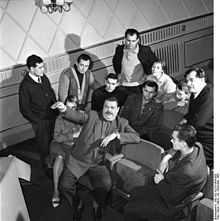Maxim Vallentin

Maxim Gerhard Vallentin (born October 9, 1904 in Berlin ; † September 2, 1987 ibid) was a German actor , theater director , SED-ZK member and long-time director of the Berlin Maxim Gorki Theater .
Life
Maxim Vallentin was a son of the actor Richard Vallentin (1874-1908) and the actress Elise Zachow-Vallentin (1876-1923). The textile artist Ruth Cidor-Citroën (1906–2002) trained at the Bauhaus was a cousin. In 1921 he took acting lessons at a drama school in Berlin, after which he worked as an actor at the theater under well-known directors such as Leopold Jeßner and Max Reinhardt . Only six years later he expanded his field of activity and became the theater director of the agitprop group Das Rote Sprachrohr , which he directed until 1932. He was also the editor of the eponymous magazine.
In 1933 Vallentin left together with his wife Edith geb. Wolff (1903–1989) Germany and fled via Prague in 1935 to the Soviet Union, where he came into contact with the general acting teaching method there based on the Stanislavski system. From 1935 to 1937 Vallentin was employed in Dnepropetrowsk as a senior director at the German Regional Theater, where he staged Kleist's "The Broken Krug" in 1936, and from 1937 to 1938 as a director at the State Theater in Engels. As a result of a denunciation he was expelled from the KPD in 1938, but he was rehabilitated in the same year and re-admitted to the party, and from 1938 to 1945 he worked for the German-language editorial team of Moscow Radio. After the end of National Socialism , he returned to Germany with the Soviet occupation forces, where he co-founded the drama department of the Weimar Music School. The then commander of the Soviet military administration in Thuringia, Kolesnitschenko , initiated the establishment of the German Theater Institute in Weimar in 1947 "in view of the great need to train new theater staff for Germany's democratic art" . In addition to Vallentin, Ottofritz Gaillard and Otto Lang were founding members , who based the curriculum on the Stanislavski system. With reference to the Stanislawski system, Vallentin and Langhoff carried out their disputes with the school, which was shaped by Brecht.
In 1952 Vallentin took over the management of the East Berlin Maxim-Gorki-Theater, whose ensemble he recruited mainly from the Leipzig Theater School or its former institutes. He worked as director at this venue until 1968, and was also director of the Berliner Volksbühne during the 1964/65 season .
He is buried in the Dorotheenstädtischer Friedhof in Berlin.
Awards / honors
- May 6, 1955: Patriotic Order of Merit in silver
- 1955: National Prize of the GDR III. class
- 1962: National Prize of the GDR, 2nd class
- August 7, 1964: Goethe Prize of the City of Berlin
- 1965: Member of the Academy of Arts in the GDR
- 1976: Patriotic Order of Merit in Gold
- 1984: Gold medal for the Patriotic Order of Merit
Fonts
- Hannes Küpper , Maxim Vallentin: The thing is that . Kiepenheuer, Potsdam 1924.
- Maxim Vallentin: From impromptu to the piece. An ensemble book based on the Stanislavsky system . Construction, Berlin 1949.
literature
- Vallentin, Maxim . In: Proletarian Revolutionary Literature 1918 to 1933 . People and Knowledge, Berlin 1970, p. 325. (= contemporary writers 9)
- Peter Diezel: "They don't need us here": Maxim Vallentin and the German-speaking exile theater in the Soviet Union 1935–1937. Letters and documents . Bostelmann & Siebenhaar, Berlin 2000.
- Bernd-Rainer Barth : Vallentin, Maxim . In: Who was who in the GDR? 5th edition. Volume 2. Ch. Links, Berlin 2010, ISBN 978-3-86153-561-4 .
- The counter-foundation . In: Berliner Zeitung , October 30, 2002
Web links
- Maxim Vallentin in the Internet Movie Database (English)
- Literature by and about Maxim Vallentin in the catalog of the German National Library
- Maxim Vallentin Archive in the Archive of the Academy of Arts, Berlin
Individual evidence
- ↑ Simone Barck / Anneke de Rudder / Beate Schmeichel-Falkenberg: Women in Soviet exile. Lukas 2003, p. 246.
- ^ Entry Vallentin, Maxim in: Biographical Databases of the Federal Foundation for the Processing of the SED Dictatorship
- ↑ theaterheute.de ( Memento of the original from September 28, 2007 in the Internet Archive ) Info: The archive link was inserted automatically and has not yet been checked. Please check the original and archive link according to the instructions and then remove this notice.
- ↑ Jochen Staadt (ed.): The conquest of culture begins! - The state commission for art affairs in the GDR (1951–1953) and the cultural policy of the SED. Peter Lang, Frankfurt a. M. 2011, p. 370.
| personal data | |
|---|---|
| SURNAME | Vallentin, Maxim |
| ALTERNATIVE NAMES | Vallentin, Maxim Gerhard (full name) |
| BRIEF DESCRIPTION | German actor, theater director, SED-ZK member and longtime director of the Berlin Maxim-Gorki-Theater |
| DATE OF BIRTH | October 9, 1904 |
| PLACE OF BIRTH | Berlin |
| DATE OF DEATH | 2nd September 1987 |
| Place of death | Berlin |
